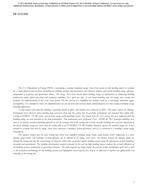
DE-13-C030 — Understanding Building Infrastructure and Building Operation Through DOE Asset Score Model: Lessons Learned from a Pilot Project
Click here to purchase
The U.S. Department of Energy (DOE) is developing a national voluntary energy Asset Score system to help building owners to evaluate the as-built physical characteristics (including the building envelope and mechanical and electrical systems) and overall building energy efficiency, independent of occupancy and operational choices. The energy Asset Score breaks down building energy use information by simulating building performance under typical operating and occupancy conditions for a given use type. A web-based modeling tool, the energy asset scoring tool facilitates the implementation of the Asset Score system. The tool consists of a simplified user interface built on a centralized simulation engine (EnergyPlus). It is intended to reduce the implementation cost for the users and increase model standardization over that of typical building energy modeling approaches. A pilot project with forty-two buildings (consisting mostly of offices and schools) was conducted in 2012. This paper reports the findings.
Participants were asked to collect building data and enter them into the scoring tool. If available, participants also provided their utility bills, existing ENERGY STAR scores, and previous energy audit/modeling results. The results from the asset scoring tool were compared with the building energy use data provided by the pilot participants. Two comparisons were performed. First, ASHRAE 90.1 prototype buildings were used as an industry standard modeling approach to test the accuracy level of the scoring tool. Second, the pilot buildings were used for comparison of the actual building energy use, either from the utility bills or via ENERGY STAR Portfolio Manager, against the modeled energy use. It was intended to examine how well the energy Asset Score represents a building’s system efficiencies, and if it is correlated to a building’s actual energy consumption.
The analysis showed that the asset scoring tool, which uses simplified building energy model, could provide results comparable to a more detailed energy model. The buildings’ as-built efficiency can be reflected in the energy Asset Score. An analysis between the modeled energy use through the scoring tool and the actual energy use from the utility bills can further inform building owners about the effectiveness of their building’s operation and maintenance. The building infrastructure analysis provided by the tool can help building owners evaluate the as-built efficiencies of the building systems, independent of operational decisions. The pilot program has helped define the path for further development of the tool as well as the evaluation methodology for the building systems and highlighted several aspects that need to be addressed to improve the applicability and reliability of the scoring tool.
Citation: ASHRAE Conference Papers, Denver, CO
Product Details
- Published:
- 2013
- Number of Pages:
- 8
- File Size:
- 1 file , 720 KB
- Product Code(s):
- D-DE-13-C030


